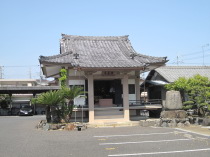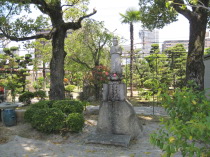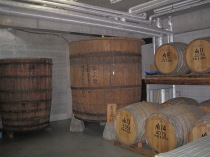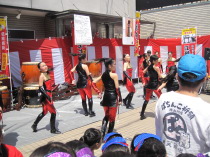Weekly Topics/Archive
April 2014
|
According to the city's public relations magazine KUSATSU, this year Kusatsu
City
marks its 60th anniversary and so the Kusatsu Syukuba Festival will be held on March
27 on a large scale in commemoration with it.
The Festival, which is a big event in Kusatsu and has become its special
feature of
spring, also marks its 46th anniversary.
It's been 3 years since I moved to Kusatsu but I haven't watched the festival.
So I decided to go to watch it today.
In the Edo period, Kusatsu in which Nakasendo Road branches off from Tokaido Road
once flourished as the 52nd post town of the "Tokaido Gojusan-tsugi" (Fifty-three
Stations of the Tokaido).
The event that reproduced its past bustle is the Kusatsu Syukuba Festival.
In the area on the east side of JR Kusatsu station, the white curtains which create
a festive mood and the flags with printed character “Kusatsu Syukuba Fesival” are
flapping in the wind.

The area near the east exit of JR Kusatsu Station |
|
The festive theme is “The town for Tokaido Road and Nakasendo Road to meet”.
I headed to Syukuba-kaido zone that is the main festive street.
I arrived near the fork between the old Tokaido Road and the old Nakasendo
Road.
This area had once been the center of Kusatsu-juku.
A stone marker with a Hibukuro (the place where the
fire is lit) stands there.
It must have been a guidepost for travelers who come
and go on the Tokaido Road and the Nakasendo Road.
It still retained a vestige of the era.
It has the guide signs “The right road is the Tokaido
Road connecting with the Isemichi on the way.
The left road is the Nakasendo Road connecting
with the Minoji on the way.”inscribed on the surface.
The Isemichi means the Iseji Road and the Minoji means the Mino Road.
When I go ahead further, Syukuba-kaido zone is gradually getting crowded with
visitors.
There was one of the old Kusatsu-juku Headquarters.
They functioned as the special inns for providing accomodation for privileged
class
such as kuge (aristocratic class), daimyo (feudal lord) and so on.
|
|
|
| Kusatsu-juku Headquarter which is a officially-designated historical site |
This is a street performance.
A party of Chindon-ya with showy makeup and flashy costumes came parading
along
the street to create a festive atomosphere while beating drums loudly.
One of the members is a foreign lady.
She allowed me to take a picture of her.
The festival enters its key stage soon.
The parade started around 10:45 a.m.
I visited Jouzenji temple in the interval.
It had special admission during the festival.
Seated statue of Amida Nyorai and two attendants statues, which are designated
as
a nationally important cultural property, was specially open to the public.
I have never known this temple to be in such a place.
According to “Jouzenji Ryaku Engi”(temple's historical book), it was founded
in 735
(Tenpyo 7) by Priest Roben.
It's said that it's the oldest famous temple in Kusatsu-juku area.
Maybe they are the chief priest and his wife.
I recieved an adequate explanation for the temple from them.
Pls click the picture to see a full-size version.
 The main hall of Jouzenji temple The main hall of Jouzenji temple
|
|

Seated statue of Amida Nyorai and two attendants statues |
|

The temple ground
|
|
Since Ohta Sake Brewing Co., Ltd. with brand-name “Dokan” opened its sake
brewery
to the public, I took a tour of the facility.
When I entered the sake brewery, I drank sake as a treat.
Since it was very tasty, I couldn't help but have another serving.
After all, I really love sake!
Pls click the picture to see a full-size version.

The origin of Ohta Sake Brewing Co.,Ltd |
|

Old tuns in the brewery
|
|

Sake as a treat
|
|
When I went out of brewery, I could see that sake tasting event is held
in front of it.
Off course, I took part in it.
|
|
|
|
| The scene of sake tasting event |
A bottle of refined sake “Dokan” as a souvenir |
Participants taste three types of sake of which grade lavel was masked
and then judge
which sake is Ginjo-shu, Junmai-shu or Honjozo-shu.
When we left here, we received a bottle of Seishu (refined sake) “Dokan”
as a souvenir.
Ohta Sake Brewing Co., Ltd that has ancestral ties with Ohta Dokan who
constructed
Edo-jo Castle is really generous, isn't it?
The street was getting very crowded with visitors around noon.
The street performances reached an extreme here and there, and became
busy.
Mr.Hashikawa, mayor of Kusatsu City, who is exective chairman of the planning
committee for the festival on the beat allowed me to take a picture of
him, too.
Pls click the picture to see a full-size version.

Street performance(1)
|
|
 Street performance(2) Street performance(2)
|
|

Mr.Hashikawa, Mayor of Kusatsu
City, on the beat (left) |
|
Kusatsu Jidai Gyoretsu as the main event is coming this way soon.
A young camerawoman of Asahi Shinbun is raring to go with a big telecamera.
She said to me she's a new employee and this is the fourth day since she has
transferred from Tokyo.
As may be expected of a press camerawoman, she is waiting for the parade at the best
photo spot like me.
The front of the procession has come.
Kusatsu Jidai Gyoretsu reproduces processions that headed toward Edo through
Kusatsu-juku when Atsuhime and an imperial princess Kazunomiya were married
into
the Tokugawa family.
In the processions, about 150 citizens wearing gorgeous costumes in the
Edo Period
parade through streets for 3 hours.
The head of the procession is Atuhime's one.
Her vehicle is a “Okago (palanquin)” which shows the samurai authority.

The 13th shogun Iesada Tokugawa and Atuhime riding on the Dashi (float) |
|
Pls click the picture to see a full-size version.
Kazunomiya's procession followed.
Her vehicle are “Soukaren”on which only imperial family was allowed to
ride and “gissha (oxcart)” in karahafu style at the tail end of the procession.
Kazunomiya is the 8th Princess of Emperor Ninkou.
She was married with the 14th syogun Iemochi Tokugawa under “the policy of
kobu-gattai” which was planned to achieve reconciliation between the imperial
court and the Tokugawa shogunate.
Therefore, Atuhime is Kazunomiya's mother-in-law.
They took a break here at Kusatsu-juku when they married into the Tokugawa
family.
When I'm watching this historic pageant, I remember Kyoto's Jidai Matsuri.
Kusatsu's procession is a smaller scall than Kyoto's one.
However, the costumes and instruments don't pale compared to Kyoto's ones.
They are excellent.
Lastly, I went to another event zone, tenjogawa zone.
On a specially arranged stage which was set up on the riverbed of old Kusatsugawa River (ceiling river), some group that have played an active role in Kusatsu were
scheduled to give a performance.
Members of a brass band club of Tamagawa High School were just playing.
“An Evening of Kusatsu Takigi-noh” will be held here in this evening.
Well, I enjoyed Kusatsu Syukuba Festival with a wide variety of events.
It's already past 1pm.
Since I got tired from walking and also got hungry, I walked to a restaurant.
Now, what do I want to eat?
[Note] public relations magazine ; 広報誌,mark the _th anniversary ; _周年を迎える
Kusatsu Syukuba Festival ; 草津宿場まつり, special feature ; 風物詩
branch off from 〜 ; (道路などが)〜から分岐する, flourish ; 栄える,post town ; 宿場町
bustle ; 賑わい, the flag is flying in the wind ; 風で旗がはためく
Syukuba-kaido zone ; 宿場街道ゾ−ン, fork ; 分岐点, Kusatsu-juku ; 草津宿
stone marker ; 石造りの道標,Hibukuro ; 火袋,guidepost ; 道しるべ
retain a vestige of 〜 ; 〜の名残をとどめる, inscribe ; (石などに文字)を彫る
Kusatsu-juku Headquarters ; 草津宿本陣,functioned as 〜; 〜として機能する
privileged class ; 特権階級,kuge (aristocratic class) ; 公家(貴族階級)
daimyo (feudal lord) ; 大名,officially-designated historical site ; 国指定史跡
Chindon-ya ; チンドン屋,showy makeup ; 派手な化粧,flashy ; 奇抜な
parade along the street ; 練り歩く,The temple has special admission ; 特別拝観を行う
Seated statue of Amida Nyorai and two attendants statues ; 阿弥陀如来坐像と両脇侍像
sake brewery ; 酒蔵,take a tour of 〜; 〜を見学する,sake as a treat ; 振舞い酒
can't help but 〜(動詞原型); つい〜してしまう,have another serving ; 御代りする
tun ; 醸造桶, 大だる,sake tasting event ; 利き酒会,mask ; を隠す
Ginjo-shu / Junmai-shu / Honjozo-shu ; 吟醸酒 / 純米酒 / 本醸造酒
have ancestral ties with 〜 ; 〜(人を)祖先とする,generous ; 気前の良い, mayor ; 市長
exective chairman of the planning committee for 〜 ; 〜の実行委員会委員長
on the beat ; (持ち場を)巡回中,Jidai Gyoretsu ; 時代行列, telecamera ; 望遠カメラ
be raring to go ; 張り切っている,今か今かと待ちきれない,join a company ; 入社する
as may be expected of 〜; さすがに〜だけあって,marry into 〜 ; 〜に嫁がせる/に嫁ぐ
palanquin ; 駕籠(かご), samurai authority ; 武家の権威, Dashi (float) ; 山車(だし)
gissha(oxcart) ; 牛車,in karahafu style ; 唐破風の,at the tail end of 〜; 〜の最後部の
the policy of kobu-gattai ; 公武合体政策,reconciliation ; 融和,imperial court ; 朝廷
Tokugawa shogunate ; 徳川幕府,tenjogawa(ceiling river) ; 天井川
pale compared to 〜; 〜に比べると見劣りがする, a specially arranged stage ; 特設ステ−ジ
riverbed ; 河川敷, play an active role in 〜 ; 〜で活躍する
An Evening of Kusatsu Takigi-noh ; 草津薪能の夕べ, get tired from walking ; 歩き疲れる
Japanese Diary / No.610−2014.04.27 / 「第46回 草津宿場まつり」 Diary / No.610−2014.04.27 / 「第46回 草津宿場まつり」
 TOPペ−ジへ戻る TOPペ−ジへ戻る
|
|